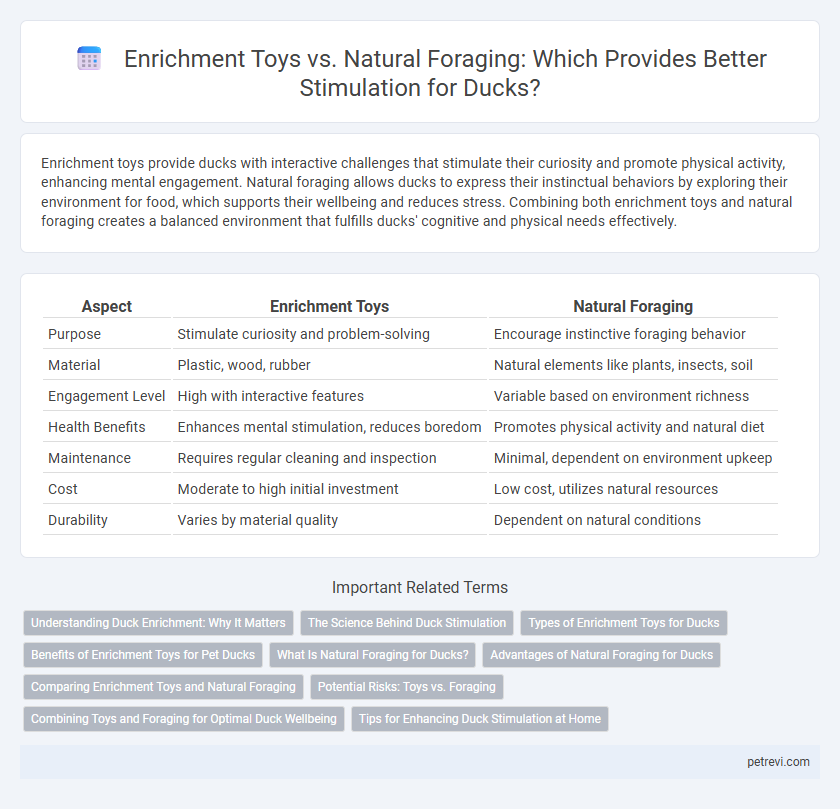Enrichment toys provide ducks with interactive challenges that stimulate their curiosity and promote physical activity, enhancing mental engagement. Natural foraging allows ducks to express their instinctual behaviors by exploring their environment for food, which supports their wellbeing and reduces stress. Combining both enrichment toys and natural foraging creates a balanced environment that fulfills ducks' cognitive and physical needs effectively.
Table of Comparison
| Aspect | Enrichment Toys | Natural Foraging |
|---|---|---|
| Purpose | Stimulate curiosity and problem-solving | Encourage instinctive foraging behavior |
| Material | Plastic, wood, rubber | Natural elements like plants, insects, soil |
| Engagement Level | High with interactive features | Variable based on environment richness |
| Health Benefits | Enhances mental stimulation, reduces boredom | Promotes physical activity and natural diet |
| Maintenance | Requires regular cleaning and inspection | Minimal, dependent on environment upkeep |
| Cost | Moderate to high initial investment | Low cost, utilizes natural resources |
| Durability | Varies by material quality | Dependent on natural conditions |
Understanding Duck Enrichment: Why It Matters
Duck enrichment improves mental and physical health by encouraging natural behaviors such as foraging, problem-solving, and exploration. Enrichment toys provide controlled stimulation, promoting dexterity and curiosity, while natural foraging mimics wild conditions, enhancing instinctual feeding patterns and environmental interaction. Both methods are essential for preventing boredom and stress, significantly boosting overall well-being and longevity in domestic ducks.
The Science Behind Duck Stimulation
Duck stimulation relies on activating natural foraging behaviors and cognitive engagement, which are essential for mental and physical well-being. Enrichment toys mimic environmental challenges, promoting problem-solving skills and reducing stress, while natural foraging taps into instinctual behaviors that provide sensory and nutritional benefits. Scientific studies show that combining both methods enhances neuroplasticity and overall health by simulating diverse ecological conditions ducks experience in the wild.
Types of Enrichment Toys for Ducks
Enrichment toys for ducks include floating balls, treat-dispensing puzzles, and colorful mirrors designed to stimulate their natural curiosity and foraging instincts. These toys encourage physical activity and mental engagement by mimicking the challenges ducks face while searching for food in the wild. Incorporating textured mats and hanging objects can also enhance sensory stimulation and promote problem-solving behaviors.
Benefits of Enrichment Toys for Pet Ducks
Enrichment toys provide pet ducks with essential mental stimulation that mimics natural behaviors, promoting cognitive development and reducing stress. These toys encourage problem-solving and physical activity, which improve overall health and prevent boredom-related behaviors. Offering a variety of enrichment toys tailored to ducks' natural foraging instincts enhances their well-being and encourages active, engaged lifestyles.
What Is Natural Foraging for Ducks?
Natural foraging for ducks involves allowing them to explore and search for food in their environment, mimicking their wild behavior by digging, dabbling, and pecking in soil, water, and vegetation. This type of stimulation promotes mental engagement, physical exercise, and natural feeding habits that contribute to overall well-being and stress reduction. Natural foraging supports a more diverse diet, including insects, plants, and small aquatic animals, which enhances nutrient intake compared to controlled feeding methods.
Advantages of Natural Foraging for Ducks
Natural foraging provides ducks with essential mental and physical stimulation by encouraging instinctual behaviors such as searching, digging, and probing for food, which improves their overall health and reduces boredom. It enhances their diet diversity by allowing access to natural nutrients and microorganisms found in soil, water, and plants, promoting better gut health and immune function. Natural foraging also supports environmental enrichment by mimicking wild habitats, fostering natural social interactions and reducing stress in captive or domestic ducks.
Comparing Enrichment Toys and Natural Foraging
Enrichment toys provide ducks with interactive challenges that encourage problem-solving and physical activity, enhancing their cognitive skills and preventing boredom. Natural foraging mimics wild behaviors by stimulating ducks to search for food, promoting natural instincts and varied dietary intake. Comparing both methods, enrichment toys offer controlled mental stimulation, while natural foraging supports ecological engagement and instinctual behaviors crucial for healthy development.
Potential Risks: Toys vs. Foraging
Enrichment toys for ducks can pose risks such as ingestion of small parts or toxic materials, leading to choking or poisoning, whereas natural foraging encourages instinctual behaviors with lower injury risks but potential exposure to harmful parasites or polluted environments. Toys must be non-toxic, durable, and regularly inspected to prevent hazards, while foraging areas should be monitored for contaminants and pathogens that can adversely affect duck health. Balancing enrichment toys and controlled natural foraging optimizes mental stimulation while minimizing physical and environmental dangers.
Combining Toys and Foraging for Optimal Duck Wellbeing
Combining enrichment toys with natural foraging activities enhances duck stimulation by engaging their cognitive and physical abilities more effectively. Toys designed to mimic natural foraging behaviors increase mental engagement, while access to natural foraging opportunities promotes physical health and instinctual behaviors. This integrative approach supports optimal wellbeing by reducing stress, preventing boredom, and encouraging natural duck behaviors.
Tips for Enhancing Duck Stimulation at Home
Enrichment toys such as treat-dispensing balls and floating puzzles provide ducks with interactive challenges that mimic natural foraging behaviors, promoting mental and physical activity. Incorporating natural foraging opportunities like scattering grains in shallow water or providing access to pond vegetation enhances ducks' instincts and prevents boredom. Combine these methods by rotating toys and varying foraging materials regularly to maintain engagement and encourage diverse stimulation in a home environment.
Enrichment Toys vs Natural Foraging for Duck Stimulation Infographic

 petrevi.com
petrevi.com